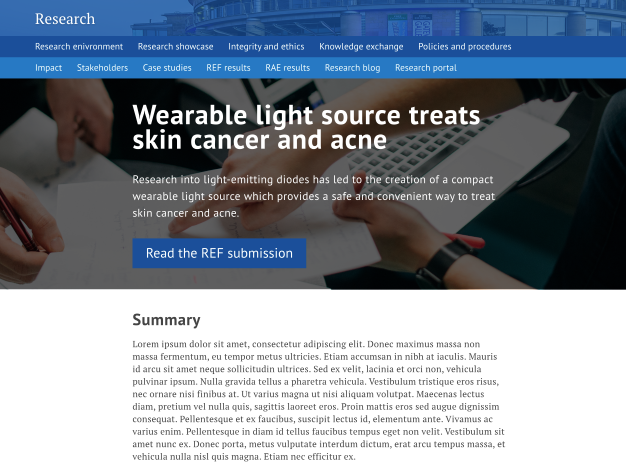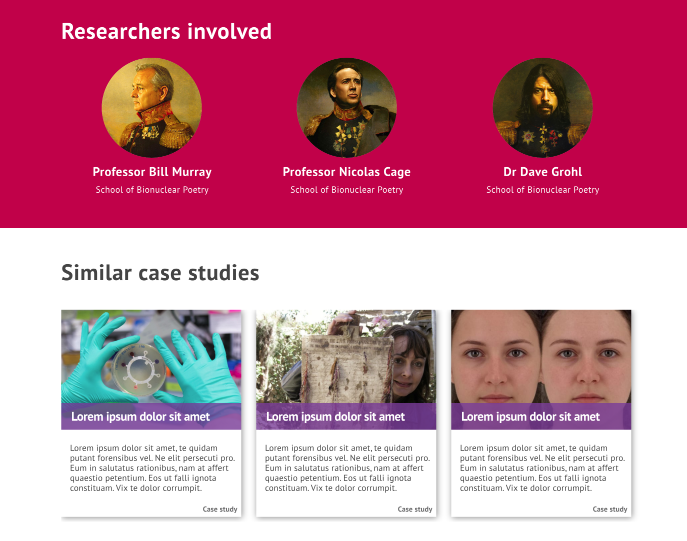Showcasing research through content
The main feature of the new research website will be the research showcase section. This section will highlight the world-leading research taking place across St Andrews to internal and external researchers, prospective students, and the general public.
We plan to launch the new research showcase section, along with a revamped research homepage, shortly before graduation in June 2018. When the showcase is launched, it will include brand new content in the form of case studies and long-forms to exemplify the research taking place at St Andrews.
Case studies
Case studies are a new type of static webpage which be hosted in the new research showcase section. These case studies will feature research stories which have had some form of impact.
See prototype of a case study page.

Case studies should meet the following criteria:
- Research discussed has been completed. (Ongoing research is too dynamic to work for a static webpage, but could be added as a blog post to the new research blog.)
- Research led to some form of non-academic impact (e.g. towards public understanding, health and welfare, culture, technology, policy or laws, the environment, or economy).
- Research is of interest to an intellectual but lay audience. Case studies are written to be accessible by anyone with an interest; jargon is removed and complex ideas are explained.
The case studies are typically written by a member of the digital communications team, who are also responsible for building them as a webpage. However, we have created a template that anyone wishing to submit an idea for a case study could use. This template covers the following areas:
- Webpage title (less than 10 words) – concisely and accurately describes the case study.
- Introduction (less than 100 words) – brief description of the key findings from the research and its impact.
- Summary (less than 900 words) – summary of the research, including the process, findings, challenges, etc.
- Impact (max five bullet points; each bullet can only be two sentences long) – key impact outcomes from the case study.
- Awards (bullet list) – any awards or honours given to the research.
- Researchers – list of St Andrews researchers involved, including profile images and links to their Pure profiles and their School or Department.
- Similar case studies – list of three related case studies, chosen at the discretion of the digital communications team.
- Credits – related publications with DOI; affiliated groups, centres, institutes or collaborations; funding bodies.
- Meta content – title and description for a front page tile; positive and negative keywords; media.

New case studies
We will launch the showcase section with 10 new case studies. We identified 10 stories from REF 2014 that have ongoing or wide-reaching impact and have already contacted the relevant researchers who have agreed to let us use their REF case studies for these new pages. These stories span a vast range of academic disciplines from statistics and medicine to history and literature.
In the future, we plan to write case studies about non-REF research as well. We want to highlight research stories which may not have been submitted for REF, but which are still valuable and important.
Long-forms
Long-forms are digital narratives written in a journalistic style for the web. They use digital multimedia and other interactive elements to engage the readers.
See examples of long-form stories.
Similar to case studies, research discussed in long-forms should be completed bodies of work with some form of impact. In addition, long-forms should meet the following criteria:
- Clear narrative arc. Long-form stories should have a clear start to finish narrative line.
- Long-forms can be reused. Content should be “evergreen” – that is, it should never go out of date or become factually incorrect. Ideally, we could promote the story time and time again.
- Typically 2,000 words in length. Long-forms are much longer than case studies and go into topics in more depth. They also include mini breakaway stories related to the topic.
New long-form stories
We will launch the showcase section with two new long-forms:
- Communicating with people who have advanced dementia – focused on research led by Dr Maggie Ellis in the School of Psychology and Neuroscience.
- Preserving our coastal heritage – focused on research led by Tom Dawson in the School of History
Submit ideas for the showcase
Do you have an idea for a case study or a long-form? Please submit them to us at [email protected].
We may not be able to publish new stories right away, but we would love to have a backlog of ideas we could pull from for future content creation.